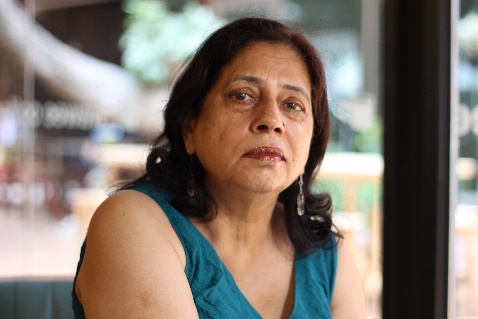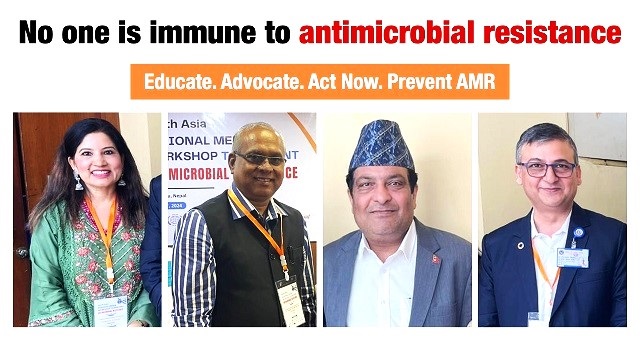


"Even the healthiest amongst us could face a life-threatening situation through a minor injury, routine surgery, or common lung infection, if antimicrobials fail,” said Dr Rajesh Sambhajirao Pandav, World Health Organization (WHO) Representative to Nepal. “For those with pre-existing conditions like cancers, HIV, or diabetes, an untreatable infection can become an unexpected and deadly adversary.”
Why do infections become difficult to treat or untreatable?
Antimicrobial resistance (AMR) occurs when bacteria, viruses, fungi, or parasites change over time and become resistant to (or no longer respond to) medicines, making infections harder (or impossible) to treat and increasing the risk of disease spread, severe illness and death. Misuse and overuse of medicines fuels AMR.
It is important to remember that it is the disease-causing microbe (and not the human being, animal or plant which is being treated) that becomes resistant to medicines. Therefore, even if a person uses antimicrobial medicines responsibly, they are still at risk of acquiring a drug-resistant infection.
Resistant microbes can pass between animals, plants and food, and in the environment. A "One Health" approach which recognises that the health of animals, humans, plants and the environment are interlinked is therefore essential to respond to AMR.
No one is immune to AMR
AMR threatens to unravel a century of medical progress, turning once treatable infections into untreatable life-threatening conditions, said Dr Pandav. "AMR is identified by the WHO as one of the top 10 global health threats facing humanity. AMR is making infections harder to treat, leading to prolonged hospital stays, higher medical costs, and increased disability, morbidity, and mortality. AMR has a real and devastating impact on individuals, families, environmental health, agricultural and food productions, and livelihoods." Dr Pandav was speaking as a Guest of Honour at the South Asia Sub-Regional Media Workshop to prevent Antimicrobial Resistance (AMR) held in Kathmandu, Nepal. The workshop was organised by Health TV Online along with co-hosts, including Ministry of Health and Population of government of Nepal, Nepal Health Research Council of government of Nepal, Global AMR Media Alliance (GAMA), and partners.
Almost 5 million people died of AMR in a year
“In 2019 it was estimated that almost 5 million deaths were associated with bacterial AMR including 1.27 million deaths being directly caused by it. Raising awareness is our first line of defence against AMR. It is a collective responsibility, and media plays a crucial role to shape public opinion, influence policy, and dispel myths and misinformation. Public messaging on AMR in media needs to be simple, consistent, and clear,” said Dr Pandav.
“Four quadripartite agencies that have joined hands to combat AMR globally include the Food and Agriculture Organization of the United Nations (FAO), WHO, World Organisation for Animal Health (WOAH) and United Nations Environment Programme (UNEP). In a meeting in 2022, they had identified working with media as one of the top four priorities. South Asia Media Workshop to prevent AMR was organised to raise awareness among media personnel and increase their active engagement on AMR and addressing it with One Health approach,” said Kalpana Acharya, Organising Chairperson of South Asia Media Workshop to prevent AMR, Editor-in-Chief of Health TV Online, and founding Board Member of Global AMR Media Alliance (GAMA).
Nepal’s response to AMR challenge
“I would like to commend Nepal government’s Ministry of Health and Population for their leadership and initiatives already taken to tackle the AMR challenge. Nepal has successfully endorsed the National Action Plan on AMR. At the 77th World Health Assembly two months back, governments, including that of Nepal, endorsed the resolution to accelerate national and global responses to AMR,” informed Dr Pandav.
“In Nepal in 2019, there were 6400 deaths attributable to AMR and 23200 deaths associated with AMR. Nepal has the 153rd highest death rate per 100,000 population associated with AMR across 204 countries. AMR was the third biggest cause of death in 2019 in Nepal (after cardiovascular diseases and chronic respiratory diseases). The number of AMR deaths in Nepal is higher than deaths from neoplasms, respiratory infections and TB, digestive diseases, maternal and neonatal disorders and diabetes and kidney diseases,” said Dr Madan Kumar Upadhyaya, Chief of Quality Standards and Regulation Division, Ministry of Health and Population of Nepal. He also Chairs AMR National Technical Working Committee and serves as a Member Secretary of AMR National Steering Committee of government of Nepal.
Discovery of penicillin was a breakthrough moment in 1928 but resistance against penicillin was reported in 1940s – soon after it came into the market. Methicillin resistant S.aureus (MRSA) was reported in 1961. Microbes are becoming resistant to the medicines we have - due to their misuse or overuse. And now it is 30 years since a new class of antibiotics was last introduced, shared Dr Upadhyaya.
Nepal is a signatory to Jaipur Ministerial Declaration on AMR 2011 when South-East Asia region of the WHO became the first WHO region to adapt it.
Dr Upadhyaya shared that Nepal's National Action Plan on AMR (2024-2028) is currently awaiting the endorsement from the cabinet. It has already been endorsed by the National Technical Working Group on AMR, Finance Ministry of Nepal, National Planning Commission of Nepal, and Social Committee of the Nepal’s cabinet.
The National Action Plan on AMR (2024-2028) of Nepal has five strategic priorities, each with its time-bound activities, managed by a government agency (focal point) with supporting partners.
1. Improve awareness and understanding of AMR through effective communication, education and training
2. Strengthen the knowledge and evidence through surveillance and research
3. Reduce the incidence of infection through effective infection prevention and control
4. Optimise the use of antimicrobial agents in human, animal and food, and
5. Promote investments for AMR activities, research and innovations.
Ministry of Health and Population of Nepal is the national focal point for AMR. Nepal’s Department of Drug Administration is the national focal point for antimicrobial consumption. Nepal’s Veterinary Standards and Regulatory Laboratory is the national focal point for antimicrobial use in animal health sector. Nepal’s National Public Health Laboratory is the national focal point for AMR surveillance in human health. Nepal’s Central Veterinary Laboratory serves as the focal point for AMR Surveillance in animal health. Nepal’s Department of Food Technology and Quality Control serves as a focal point for AMR surveillance in food sector, and Department of Environment is the focal point for AMR in environment, said Dr Madan Kumar Upadhyaya.
“Implementation and monitoring of National Action Plan on AMR is challenging with limited technical capacity and budgetary resources. Limited access to diagnostic microbiology facilities (at subnational level) and access to antimicrobials is another challenge,” said Dr Upadhyaya.
Right and timely diagnosis and right treatment is key
Good plan has to be followed by a greater implementation on the ground. “We have to find an effective strategy to implement the National Action Plan on AMR. More importantly, we have to take it to the local level and ensure that right antimicrobials are prescribed, right amount of medicines are taken and for the right disease,” said Dr Roshan Pokhrel, Heath Secretary, Ministry of Health and Population of Nepal. “We need to make progress in combating AMR and measure the progress too (with right data) to ensure that we are preventing AMR.”
World leaders will convene on 26th September 2024 at the United Nations General Assembly High-Level Meeting on AMR. This is the second such meeting. The first UN High-Level Meeting on AMR was held in 2016 which resulted in significant global and national actions to address AMR with One Health approach. Participants in Nepal called upon the world leaders for stronger commitments matched with concrete actions to prevent AMR.
Later this year, the World AMR Awareness Week (18-24 November 2024) will be observed worldwide on the theme: Educate, Advocate and Act Now.
(Shobha Shukla is the award-winning founding Managing Editor and Executive Director of CNS (Citizen News Service) and is a feminist, health and development justice advocate. She is a former senior Physics faculty of prestigious Loreto Convent College and current Coordinator of Asia Pacific Regional Media Alliance for Health and Development (APCAT Media) and Chairperson of Global AMR Media Alliance (GAMA). Follow her on Twitter @shobha1shukla or read her writings here www.bit.ly/ShobhaShukla)